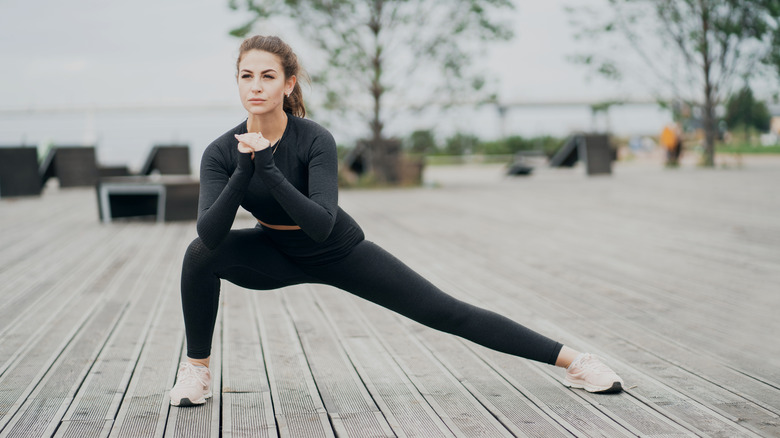What Are High Knees And Why Should You Add Them To Your Workout?
You probably have not-so-fond memories of doing high knees during gym class or soccer practice when you were a kid. While this exercise is certainly not the easiest, there are plenty of good reasons for you to add it back into your workout routine. According to Healthline, you should always wear comfortable and supportive shoes before performing high knees. To do this exercise, stand with your feet shoulder-width apart and keep your arms at your sides. Next, lift one knee as high as you can toward your chest while lifting the opposite arm to keep your balance, just like you would while running. Quickly lower your knee and arm and repeat the motion with your other leg and arm. Repeat this motion for both legs and arms for your desired amount of time.
High knees work your entire body and can be used as a warm up or as part of your workout. Because you are moving your entire body, this exercise is also a great cardio workout and will quickly get your heart rate up. Your lower body and core muscles are specifically targeted, so this is a great way to work that part of your body as well.
Why exercise is so important
We all understand the benefits of exercise, but sometimes it can be difficult to find the will to get up and move. However, maintaining our health and wellbeing requires frequent physical activity. There are numerous ways that exercise benefits our physical health. It improves our bones and muscles, supports a healthy weight, and lowers our chance of chronic illnesses including cancer, diabetes, and heart disease (via CDC). Additionally, exercise increases our energy levels and improves our quality of sleep.
But exercise has advantages that go beyond just physical health. Our mental and emotional health benefits greatly from exercise. Exercise can boost our mood, lessen tension and anxiety, and increase our general sense of well-being. Additionally, it helps improve memory and cognitive performance. Add some exercise to your daily schedule if you're seeking a way to enhance your health and well-being. The CDC recommends that adults get at least 150 minutes of moderate-intensity aerobic exercise (like brisk walking) every week.
Other reasons to keep your lower body strong
While it can be tempting to focus on the aesthetics of a toned upper body, no one should underestimate the importance of a strong lower body. Your risk of injuries is lower if your lower body is strong, as injuries frequently result from weak or unbalanced muscles. Your lower body's muscles can be made stronger to help build a foundation that is more evenly distributed and solid (via Hoag Orthopedic Institute). When you play sports or are just going about your daily activities, this can help lower your chance of injury. You should also consider doing more leg days if you suffer from lower back pain. Numerous things can lead to back pain, but weak muscles in the lower body are frequently to blame. Our back is put under more strain when our hips and legs are weak. According to Healthline, this may result in discomfort like pain and stiffness.
A strong lower body can also help with posture and alignment. Poor posture often leads to pain in the lower back, neck, and shoulders. When our lower body muscles are weak, it's harder to maintain good posture. This is because these muscles are responsible for keeping our spine stable. While you don't need to work your lower body every day, you should be incorporating leg and glute exercises into your routine at least once or twice per week.



